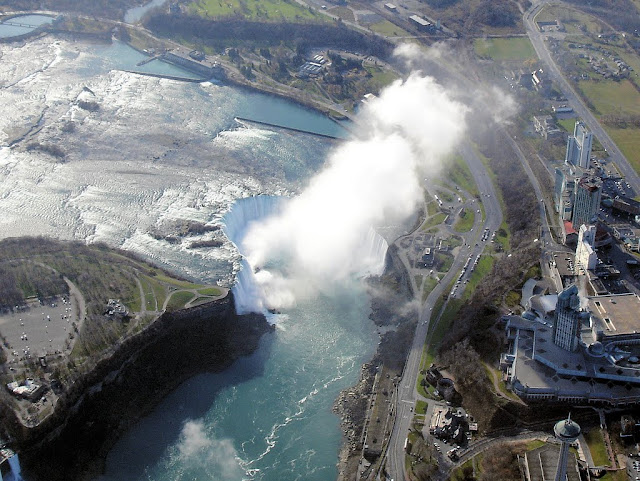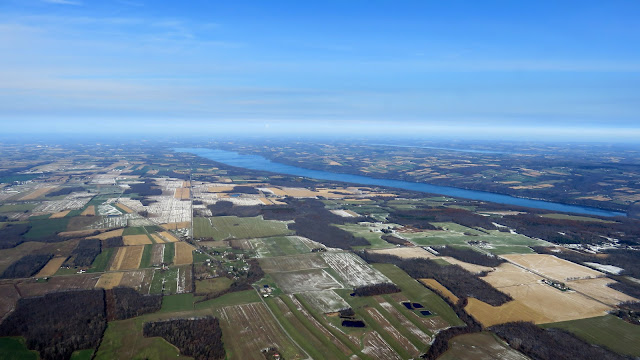"Hundred Dollar...What?"
Non-aviators might struggle to understand the attraction behind the so-called $100 hamburger (or $100
pancake, or $100
omelet, or -- if flying to Kalamazoo -- $100 Erbelli's calzone). Why would anyone spend money on flying an airplane just to grab a burger?
The most important thing to understand about the $100 hamburger is that the hamburger itself is not the point. It's an excuse to take wing, to explore the world, to have new experiences, and to share camaraderie with other pilots. I can make hamburgers and pancakes at home, but $100 hamburgers are always served with a side of aeronautical adventure.
By my reckoning, I flew sixteen $100 hamburger flights in 2017. A few were solo (e.g.,
Bethany's at Block Island State Airport). Some were with Kristy and The Bear, often as required en route during longer journeys (e.g.,
Le Bistro M in Bromont, Quebec or
Ali Baba in Morgantown, WV). The majority of them included members of the Williamson Flying Club with up to seventeen participants flying to a destination together in as many as seven aircraft (e.g.,
Lake Placid, NY and the
EAA pancake breakfast in Elmira, NY).
In all cases, even when the meal is good, it is the journey that makes it all worthwhile.
A First Time for Everything
| Date | Aircraft | Route of Flight | Time (hrs) | Total (hrs) |
| 12 Nov 2017 | N21481 | SDC (Sodus, NY) - N30 (Honesdale, PA) - SDC | 2.8 | 1735.9 |
My good friend
Ed earned his private pilot certificate in late September, coincidentally a day before my fifteenth anniversary as a private pilot. He recently checked-out in the club's Archer, Eight Five X-Ray. With keys in hand to something more closely resembling a travelling airplane, Ed was looking for an excuse to stretch his wings. He suggested a breakfast run and I suggested a destination: the Cherry Ridge Airport Restaurant in Honesdale, PA. From there, a mission was born. I invited Scott and Jamie to join me in the Warrior for the trip.
 |
| Owasco Lake |
We set out shortly after 8:00 am with Ed flying approximately five miles ahead in Eight Five X-Ray. The first snowfall of the season occurred earlier that week and the remnants still lingered on higher terrain between the Finger Lakes.
For some reason, the Pink Floyd song "Set the Controls for the Heart of the Sun" came to mind as we flew southeast toward Cherry Ridge. Scott forgot to bring his sunglasses, so I shared with him the wise words once imparted to me by my first flight instructor:
"The trick to dealing with the sun in flight is to not look at it."
Genius.
It was a beautiful morning to fly and the air was utterly still. Warrior 481 tracked so true that Jamie asked if the autopilot was engaged. Autopilot? Clearly he has my airplane confused with a fancier ship.
 |
| Ground track from Williamson-Sodus to Cherry Ridge from FlightAware. |
Though Ed had a five mile head start, Eight Five X-Ray gradually transformed from a tiny dot in the windscreen to an airplane-shaped flying object as we gradually overtook him.
Cherry Ridge
While planning the trip, I was concerned about available ramp space at Cherry Ridge during the breakfast rush. I need not have worried. A relatively early arrival meant that ours were the first two airplanes on the ramp that morning. They were soon joined by many others, but for us, parking was a snap.
 |
| Scott, Chris, and Ed. Photo by Jamie. |
 |
| Ed and Eight Five X-Ray |
Mission accomplished! It was Ed's first flight of any distance in the Archer, his first landing in a state other than New York, and his first "destination" since passing his check ride! It was a big day regardless of the particular $100 foodstuff he chose to consume at the point of landing.
Some Pipers are bigger than others. Walking around the twin, it became clear to me why the Aztec is so often referred to as the "Az-truck". It was a monster.
 |
| A full ramp after breakfast. Photo by Jamie. |
Apparently, the early bird gets the ramp space. The parking apron at Cherry Ridge filled quickly with a variety of aircraft after we landed. While watching aircraft arrive for breakfast, we were surprised to see Six Echo Sierra, the club's Skyhawk. We introduced ourselves to Bob, the WFC member flying; we did not already know each other.
Ten years had passed since I last dined at Cherry Ridge. Mom was with me on that flight. Restaurant ownership has changed, but everyone's breakfast was excellent and the view of the runway from the second story eatery was as excellent as before.
Flashback
| Date | Aircraft | Route of Flight | Time (hrs) | Total (hrs) |
| 21 Sep 2003 | N3470R | HAI (Three Rivers, MI) - OEB (Coldwater, MI) - AZO (Kalamazoo, MI) - HAI | 2.3 | 148.8 |
I remember my first breakfast flight as Pilot in Command well. I launched from Three Rivers in Seven Zero Romeo and rendezvoused with the "South Haven Tribe" (two Cherokees and a Super Decathlon out of my future home base) en route to Coldwater, MI.
 |
| Ron and Carl over southwest Michigan, photographed 21 Sep 2003. |
I recall seeing the other airplanes emerge from the morning haze and following them to our destination. Inbound to Coldwater, I had my first experience with wake turbulence when Carl, who was flying some distance ahead, abruptly veered in front of me. The abrupt roll moment that I experienced when I rode through his wake was a learning experience and memorable encounter.
 |
| Coldwater - Branch County Memorial Airport (OEB) looking to the northeast, photographed 29 April 2006. |
After landing, I followed the other three aircraft to the far northeast corner of the airport and then, to my surprise, off the pavement and along a grass taxiway that led to a restaurant hidden by a low hill.
 |
| Seven Zero Romeo parked at Coldwater, photographed 21 Sep 2003. |
My first $100 hamburger run as PIC is one of my strongest early flying memories. Do I remember anything about the meal in Coldwater? Not at all. In fact, I have a vague recollection that the restaurant was adequate, but not particularly good. But, as already noted, that was not really the point.
Back To the Present
With the sun at our tail, much less squinting occurred on the way home.
 |
| Photo by Jamie. |
 |
| Hey! Shouldn't somebody be looking straight ahead? Photo by Jamie. |
Before long, we were cruising past Owasco Lake again, entering the home stretch of sky to the Williamson-Sodus Airport.
Back at home base, Ed was deservedly excited about his first $100 hamburger flight as Pilot in Command. Sure, breakfast was
good, but the true excitement came from a brand new private pilot beginning to explore on his own.
I was glad to have been a part of it.































































